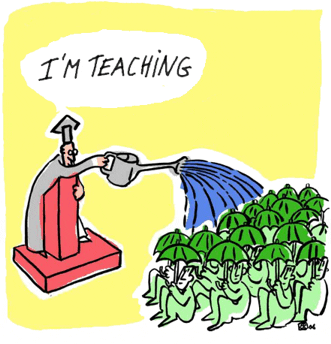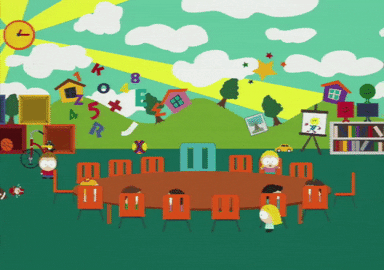Before every P.E lesson, you need to perform a warm-up with your class to prevent strained muscles. Choosing the right warm-up activity for your activity can be difficult. Some may think that any old game of tag will warm everyone up, but is this relevant to the sport your are about to teach? Does it actively warm the muscles that are going to be used throughout the lesson?
During Easter, I started coaching at a holiday camp for children, during which we teach techniques involved in different sports in a fun and progressive way. Every session requires a warm-up, and I need a never ending bank of fun activities that correspond with sport and skill I am teaching.
As the summer camp has come to an end and the October camp is fast approaching, I have been looking back and thinking about which warm-ups worked best and which were not only my favourites but also the ones the children kept asking for, so here are my Top Ten Warm-Up Activities.
10. The Beaver Song

Okay, so I’m working on a camp and camps have songs that make you sing, dance and make you look a little bit silly… But who ever said these won’t work in a school? This song, if done with it’s dance, would be great to get then heart rate raised, and for any activity which has a main focus on arm movement – tennis, badminton, passing/shooting a ball…
When I first learned this song, I was doing it everywhere, I absolutely adored it, hopefully you will be the same.
This song is great for all ages, however if I were to pick a specific age, I would say Early Years due to the nature of counting and showing the right number of fingers as your say the number.
I could type all the lyrics in this post, but the link in the sub-heading is the perfect example and is the video often used in the background to keep coaches right. Once you feel confident with the lyrics, you might even decide to change it up to fit the theme in your class.
So, Giants, Wizards and Elves is basically a massive game of Rock, Paper, Scissors.
Giant = Rock – Action: Arms up high and rawr as loud as you can
Elf = Paper – Crouches right down to the ground and makes a tickling action whilst making a really annoying noise of your choice.
Wizard = Scissors – Action: one foot forward, one arm forward as though you are holding a wand, shout “expelliarmus”
This is a game of teamwork.
Split your class in to two teams, each team goes to the wall on their side of the hall. In their teams, they must plan their attack – choose which creature they would like to be. I often do a count down from 10 in which they need to decide their attack and when I reach 1 each team runs to the middle and performs their attack. The losing team then must run back to their wall with the winning team trying to tag them. If you are tagged, you get to join the winning team for the next round.
8. Sharks and Fishes 
This is a great tag game which starts with one tagger but progresses on until there are no fish left in the sea.
To begin, choose one person to be your shark, everyone else is a fish. The shark will shout “fishy fishy, come swim in my sea” to which the fish reply “sharky sharky, you can’t catch me” and all the fish will try and run to the other side of the hall without being tagged.
If someone has been tagged, they have been bitten and this turns them into seaweed. If you are seaweed, you have to have sticky feet, meaning you cannot move from your position, you can only pivot to face the direction of the fish, but you still have to try and tag them as they run past.
You can make this game quicker by adding a few more sharks in the sea, or changing it so that if you are tagged, you become a shark rather than seaweed meaning you can run around the space.
7. Don’t Let the Balloon Touch the Ground
Okay, this one sounds basic, but it is great. I use this one with the under 8s mainly, but really I would use it at any age.
This game is great for introducing techniques in volleyball and badminton.
I always start the game with music. The children will keep the balloon from touching their floor with their own technique while the music plays, when they music stops, they grab their balloon and come back to you. when they are back, introduce a new way to stop the balloon from touching the floor:
- Give me a thumbs up, give it a hug, rest those thumbs – volleyball dig
- Hold the racquet loose with your thumb pointing to the big end, try hit the balloon forward and move with it – badminton underarm
You can lower the amount you teach with this game or increase it depending on the children you have, but I find this a fantastic way to get the skill and movement required for different sports in while playing a fun and familiar game. I even get them to play balloon volleyball over the net and once I see great techniques, I swap their balloon for a ball.
6. On the Pirate Ship

Shiver me timbers – this game is all about remembering and following instructions.
Start with 4 easy commands
Port – Run to the left side of the hall
Startboard – Run to the right side of the hall
Main Deck – Back to the middle of the hall
Scrub the decks – Down on their knees and pretend to scrub the floor
While giving the instructions, it can help to point in the direction the children should be going to begin with to help them remember.
As you progress through the game, you can start adding some new instructions:
Attention – Children stand up straight with one hand on their forehead in the attention stance
Captain’s Quarters – Everyone must run to their captain (teacher/coach)
Captain’s Coming – Everyone shouts “aye aye captain”
Man Overboard – Children wave their arms like they’re drowning
Captain’s Wife – Everyone shouts “Woot Woo” OR all the children can courtsey
Hit the Deck – Children lie down on their stomachs as fast as they can
And the list can go on further… You can even start adding in compass direction if that relates to other learning you have been doing in class.
5. Beat the Ball
This game is great for working on paying attention and ball handling skills. It is fast paced and really enjoyable for children of any age.
Children all stand in a circle facing the middle, the person starting with the ball must pass it to someone standing next to them then run around the outside of the circle in the same direction. The aim for the person running is to run around the circle faster than the ball. The aim for the children in the circle is to pass the ball to the person standing next to them so that the ball returns to the starting point quicker than the person running.
4. Man on Mars
This is another tag game that the children ask for all the time, they love it, plus it’s really simple.
You start with on person in the middle, everyone else is against a wall looking at your “man on Mars”
The children at the wall shout “Man on Mars, man on Mars, take me to the stars”
The person in the middle will then say a condition for people to run to the other side safely – Only if you are wearing blue socks
Once all the people who have met the condition have gone through, there is a countdown from 3, then everyone has to run and the person in the middle has to tag people. Anyone who has been tagged joins the people in the middle for the next round.
Older children can often run this game on their own and work as a team to decide the condition together and to catch as many people as possible. When I have a younger group, I help them out and ensure that as many children in the middle get to decide on the condition as possible and help them to shout it over.
You can restart the game at any point with a new tagger, otherwise the game ends when everyone has been tagged.
3. Traffic Lights
This game is my go to for teaching skills in movement, it’s fantastic.
For older children, vocal instructions are often enough, but for younger children I use cones in the traffic

light colours to provide a visual aid. The different colours represent different speeds the children are moving in.
Green – Running
Amber/Yellow/Orange – Walking
Red – Stop / Return to teacher/coach
I have found this game increases confidence in movement with different sporting equipment and also allows the teacher/coach to see children progressing and provide any tips to children, e.g keeping your head up as you move so you don’t bump in to people.
All you need for this is a whole load of cones and a great bunch of children!
Place half your cones facing the normal way – thin end at the top (these will be your volcanoes)
Place the other half of your cones upside-down – thin end at the bottom (These will be your craters)
Make sure they are mixed up so that you don’t have loads facing one way at one side.
Split the children in to two teams, the volcano team and the crater team. On your count, they will have to try and make all the cones face the right way for their team. Do this with a set time in mind, e.g the length of a song. At the end, the team with the most cones facing their way wins.
1. Mr Man
This game develops listening skills, paying attention, following instructions, reaction times and movement.
These are some suggestions of commands you can use, the children just need to react how they feel is appropriate for each character, but you may wish to designate specific actions to each character if you feel children may be silly without the Mr Silly character being called.
Mr Rush – Run
Mr Slow – Walk slowly
Mr Noisy – Make loads of noise whilst doing previous action 
Mr Quiet – Be silent whilst doing previous action
Mr Jelly – Shake your whole body
Mr Muddle – Walk backwards
Mr Bounce – Jump around
Mr Small – Crouch to walk or crawl
Mr Tickle – shaking your arms as you move
Mr Happy – Move around with a big smile
Mr Tall – Reach up as high as you can while walking
Mr Strong – Flex your muscles as you walk
Mr Topsyturvy – Lie on your back with arms and legs in the air
This game has a never ending list of actions and these are only a few off the top of my head. You could even ask the children to think of some of their own Mr Men and Little Miss characters and actions to go with them.
Warm-up games are a great way to introduce techniques, have some fun and warm up the areas of your body that you are about to be working. It is a crucial part of every session to prevent injuries and these have been just a few that I love to use. I would love to hear your favourite warm-up games and add them to my bank.









 I’m sure we all complained at some point about how long some of these days felt. Well, when you visit China you soon learn not to complain. Students in China often start school at 7am where they need to attend the morning assembly. There is an assembly every morning where the students sing their school song and do morning exercises; kind of like some of the primary schools in Scotland doing their Daily Mile. This is also where any announcements are made and where we were welcomed to the school.
I’m sure we all complained at some point about how long some of these days felt. Well, when you visit China you soon learn not to complain. Students in China often start school at 7am where they need to attend the morning assembly. There is an assembly every morning where the students sing their school song and do morning exercises; kind of like some of the primary schools in Scotland doing their Daily Mile. This is also where any announcements are made and where we were welcomed to the school.
 Primary schools in China also allow for learning in the corridors. With full length murals filled with facts and interactive questions where you can open the flap to find out the answer. These change regularly to keep up to date with the topics within the school. Each display also had the writing in both Mandarin and English allowing the pupils to see the translation, but also allowing us to understand what had been written on these walls, I wish my future classroom could look like that.
Primary schools in China also allow for learning in the corridors. With full length murals filled with facts and interactive questions where you can open the flap to find out the answer. These change regularly to keep up to date with the topics within the school. Each display also had the writing in both Mandarin and English allowing the pupils to see the translation, but also allowing us to understand what had been written on these walls, I wish my future classroom could look like that. The curriculum is also very different to ours. When we do handwriting, they do calligraphy. Their English lessons would be where we would do the likes of French or any other modern language, however rather than just learning the language, they will read novels and analyse them the same way we do in our own English lessons. The school I visited also have a special bell which rings telling the teachers that it is time to do eye exercises. The eye exercises are used in order to prevent too much of a strain on the eyes and to prevent students from getting sore heads. It also allows for a short interval where the students can take a breather.
The curriculum is also very different to ours. When we do handwriting, they do calligraphy. Their English lessons would be where we would do the likes of French or any other modern language, however rather than just learning the language, they will read novels and analyse them the same way we do in our own English lessons. The school I visited also have a special bell which rings telling the teachers that it is time to do eye exercises. The eye exercises are used in order to prevent too much of a strain on the eyes and to prevent students from getting sore heads. It also allows for a short interval where the students can take a breather. The student’s work is also taken very seriously in China. Where we would put our students work on a wall display or find a shelf to display creations, the Chinese school I visited had a room filled with school awards and pupils art work. Their work was fascinating and so creative, we all believed a teacher had created them.
The student’s work is also taken very seriously in China. Where we would put our students work on a wall display or find a shelf to display creations, the Chinese school I visited had a room filled with school awards and pupils art work. Their work was fascinating and so creative, we all believed a teacher had created them.
